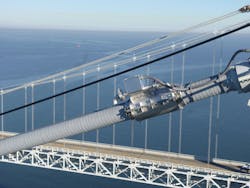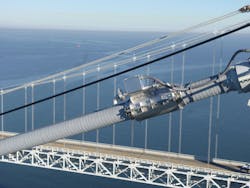A way to keep dry
When inspections of Maryland’s William Preston Lane Jr. Memorial Bridge, also known as the Bay Bridge, revealed that conventional cable corrosion protection systems in both eastbound and westbound spans were no longer effective, the Maryland Transportation Authority (MDTA) took a proactive approach to preserve the suspension cables by engaging AECOM for cable dehumidification services—having recently worked on similar cable-protection systems on bridges in the U.K.
The result was a team of structural, electrical and mechanical engineers from both sides of the Atlantic collaborating on the overall design, layout and installation of the Bay Bridge’s new cable dehumidification system, the first system of this kind installed on a bridge in North America.
The bridge consists of a dual-span crossing which rises 186 ft over the Chesapeake Bay. The eastbound bridge opened in 1952 and the westbound in 1973. The centerpieces of the bridges are two 1,600-ft-long parallel main-suspension spans. With annual traffic volume approaching 26 million vehicles, the bridges connect ocean destinations on Maryland’s eastern shore with the urban centers of Baltimore, Annapolis and Washington, D.C.
Leveraging technology
The use of dehumidification to mitigate corrosion originated from research conducted in the 1920s and ’30s. However, its application for protecting suspension-bridge cables is relatively new, with the first cable-dehumidification system on a bridge applied less than 20 years ago in Japan. The technology advanced through Asia and Western Europe where AECOM refined the work on three major suspension bridges in the U.K.—M48 Severn (2008), Forth Road (2009) and Humber (2010), and the latest advances in cable-dehumidification technology were used on Maryland’s Bay Bridge (2014/2015). Dehumidification preserves cables and extends their useful life, averting the premature need to replace the cables or, ultimately, the bridge itself.
On the Bay Bridge project, AECOM provided specialized dehumidification services, from preliminary design through construction management and inspection, including system commissioning, maintenance and monitoring of the system performance. This involved:
- An assessment of the existing electrical supply and load demands on the bridge to determine the available capacity for dehumidification equipment;
- Engineering and layout of the mechanical plant rooms;
- Detailing of cable injection and exhaust ports, and specification of the required blowing length between injection and exhaust ports—one of the most crucial aspects of successful dehumidification;
- Sizing of plant rooms and internal mechanical equipment, including dehumidifiers and injection fans, to determine if proposed electrical load would be within the capacity of the existing supply on the bridge;
- Developing a strong set of procurement documents, including plans and specifications;
- Establishing a baseline schedule for dehumidification works;
- Estimating probable cost of construction;
- Supporting MDTA throughout the bidding process; and
- Construction management and inspection work including senior resident engineer and on-site engineering support for shop witnessing, field testing, installation, commissioning and monitoring of the final detailed system.
As a first-of-its-kind project in North America, the Bay Bridge cable-dehumidification design has set a standard that is being adopted for similar applications on cable suspension bridges across the U.S. Main cables, the most critical asset on suspension bridges, have typically been protected using conventional methods, primarily by regularly renewing the paint-and-caulking or by oiling, where specially formulated linseed oil is poured into the cable to coat individual wires. Following the example of the Bay Bridge project, dehumidification is now being planned or installed on other major bridges in the U.S., including the Delaware Memorial Bridge (Delaware/New Jersey), the Philip Murray Bridge (Pittsburgh, Pa.) and the Anthony Wayne Bridge (Toledo, Ohio), with several others in the programming stage.
Fans source dry air from a plant room and pump it through pipework to ports along the cables; the dry air then permeates the voids in the cables.
Arrested development
Replacing suspension cables before the end of a bridge’s useful life can cause significant disruption to operations and cost hundreds of millions of dollars. The objective of main-cable dehumidification is to practically arrest corrosion in the cables so that bridges can achieve their 100-plus-year design life potential. When implementing cable-dehumidification systems, owners are proactively deploying cost-effective solutions to preserve not only the cables but the iconic structures they support.
Preserving the existing cables and extending a bridge’s life averts the premature use and waste of scarce resources associated with the demolition and replacement of the bridge. On the Bay Bridge project, many measures were specified to promote the installation of an efficient, environmentally conscious dehumidification system, including detailing or specifying requirements that enhance low-energy consumption, which resulted in a smaller carbon footprint. Also, using seed-based oil or dry electrical transformers eliminated the need to use petroleum oil transformers over Chesapeake Bay waters, reducing potential contamination.
Drying success
The installation of the dehumidification system was successful on many levels. Dry air was injected into the bridge’s main cables to remove trapped moisture and maintain a dry, non-corrosive cable environment. Work to seal the main cables with an air-tight, weather-resistant coating—using materials that are highly durable and require virtually no maintenance—was safely completed while the bridge remained open to traffic. The provisions for the design of the mechanical and electrical plant were intentionally kept as simple and accessible as possible to minimize energy usage and facilitate future maintenance.
At the heart of each mechanical plant room, a dehumidifier draws in outside air, removes the moisture to a targeted relative humidity (RH) and stores it in the plant room, which functions as a plenum. A fan then injects the air along pipework to ports located on the main cables. The dry air then permeates between the voids in the cable wires or strands, collects the moisture and exhausts it out of the cables as moisture-laden air. Secure, Web-based controls allow remote monitoring and adjustment of the system parameters. Continuously recorded data such as relative humidity, air pressure and flow, allows the system’s effectiveness to be monitored remotely.
AECOM designed and installed the dehumidification system—here being applied by on-site workers—on the Bay Bridge.
Removing water
Several approaches and techniques were used to maximize economic value. These included the positioning of injection and exhaust ports (sleeves); selecting cable-blowing lengths that minimize the time and energy required to initially dry the main cables; and specifying a control system that allows accurate adjustment of the air pressure, flow and humidity to efficiently maintain non-corrosive conditions. Project performance specifications were developed to minimize disruptions to traffic, which also decreased impacts on toll-generating revenue and reduced delays to the traveling public.
The contractor determined that the best solution for accessing the cable was a platform running the full length of the cables. This method enhanced efficiency by allowing multiple crews to work simultaneously. Other economic design considerations were as follows:
- Robust cable wrapping and sealing details were specified to minimize water ingress and air leakage in order to reduce long-term energy usage;
- Plant rooms were designed as plenum chambers (air-tight rooms) with efficient equipment to reduce plant capital cost and long-term running costs, allowing recovery of waste heat using a plate heat exchanger to conserve energy;
- Plant rooms were strategically located in the large concrete anchorages on the westbound bridge, which protects them from the harsh marine environment and traffic vibration. In the absence of large anchorages on the eastbound bridge, the plant room was located under the bridge on the approach deck truss, a location to help shelter the plant from solar gain; and
- Material requirements commensurate with the harsh marine environment were specified, such as marine-grade stainless steel and UV-resistant high-density polyethylene (HDPE) pipe, which reduces overall maintenance and repair costs.
The Bay Bridge project, which was substantially completed in December 2015,
has been deemed a success by MDTA. Evaluation of data shows that more than 750 gal of water have been removed from cables on the westbound bridge, commissioned in February 2014, and more than 200 gal from the eastbound span, commissioned in December 2015, resulting in reasonably dry, non-corrosive conditions within the cables.
By preserving the cables and extending the useful life of the bridge, an essential part of Maryland’s road network is being maintained, allowing commerce and tourism to continue to thrive. In addition, the successful outcome of this project is changing the way other suspension-bridge owners in the U.S. maintain bridge cables.


